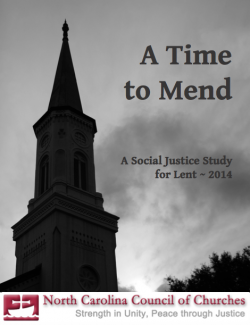 In recognition of our faithful call and of this time in history, the Council’s annual Lenten guide focuses on poverty and the ways we can respond to our sisters and brothers of low-income. We hope you and your family will find cause for reflection and inspiration for action as you share this intergenerational resource together. May we continue building as a nation toward a place where God’s love is felt by everyone through the meeting of basic human needs and the extension of true opportunities for progress.
In recognition of our faithful call and of this time in history, the Council’s annual Lenten guide focuses on poverty and the ways we can respond to our sisters and brothers of low-income. We hope you and your family will find cause for reflection and inspiration for action as you share this intergenerational resource together. May we continue building as a nation toward a place where God’s love is felt by everyone through the meeting of basic human needs and the extension of true opportunities for progress.
Click here to download “A Time to Mend: A Social Justice Study for Lent.”
Scripture: John 10:10 (NRSV)
The thief comes only to steal and kill and destroy. I came that they may have life, and have it abundantly.
Social Justice Reflection
What does it mean to have life fully and abundantly, or as this Greek word implies, life, “exceedingly abundantly, or beyond measure?” It might mean spending time with family, working in a rewarding job, helping others, or following a passion. Good health is essential to enjoying any of these things. Is a full and abundant life a luxury only the wealthy can afford?
Research shows us that certain lifestyle choices can make a drastic difference in health – things like consuming fresh fruits and vegetables and getting enough physical activity. But even when those living in poverty want to make a healthy choice, they do not have enough good options available to them. Lack of parks, walking trails, and safe neighborhoods limit the possibilities for safe physical activity. Lack of grocery stores, farmers markets, and enough money to purchase fresh produce limit the healthy foods that are consumed.
The cheapest calories are the most empty, offering refined carbs and high sugar content rather than antioxidants and disease-fighting nutrients. What this means is that our neighbors who struggle with poverty and hunger are also the ones who are disproportionately hit by obesity, diabetes, and other chronic diseases. They may be getting the calories they need to survive, but chances are they are not getting the ones they need to thrive. In order to get more calories per dollar, nourishment is sacrificed. Internationally, wealth and obesity are correlated, but we reverse that trend in the U.S., with poorer communities having higher obesity rates (and the related health problems), than wealthy ones, even though they are malnourished.
What can people of faith do to combat these trends of chronic disease and obesity that disproportionately plague those living in poverty? While corner stores and fast food restaurants often offer foods that are full of fat, sugar, and empty calories, so do many of our church-led food pantries and feeding programs. How do we help promote full and abundant lives in our communities?
Our churches can serve healthier church meals and encourage members to think through the implications of what kinds of food we are eating, donating, and serving. Healthy corner store initiatives, community gardens, and healthy food pantries offer hope for more accessible healthy food options. Churches can even open their doors and grounds to be used for physical activity through shared use agreements.
God calls us to full and abundant life, and Jesus said he came that this might be possible. Let’s all do our part to break the cycle of obesity, poor health and poverty so that this full and abundant life may be possible for all.
Closing Prayer
God of abundant life, let us truly hear your call to full and exceedingly abundant life for all of your children. Help us to find our place in promoting healthy and whole lives, starting with our own. Let this call for wholeness expand from our families to our neighborhoods, communities, cities and our state. Help us create a system where we all have a chance to be healthy. Amen.
Links
- www.healthandwholeness.org
- www.youthempoweredsolutions.org/?p=4263
- www.p4communitycare.org/programs-initiatives/nutrition-program/partnership-pantry/
Intergenerational Questions
Discuss the ways that the family works together to have a healthy life. Remember that you are your child’s best model. Ask them if they can think of ways to improve the family’s health. Select some suggestions and work together to implement them (walks after dinner, family bike rides, eating more fruit and vegetables, cooking together, have a pantry intervention replacing unhealthy foods with healthier options, less ‘screen’ time and more activity time). Make a commitment together to become healthier.
Explain that when people are poor, it is harder for them to make healthy choices. Brainstorm ways your family can help every family in your community to be more healthy. You can prompt this discussion with the activities below.
Intergenerational Activities
- Include packets of vegetable seeds for food pantries to give out with food boxes.
- Plant a garden at home or at church and donate the produce to a local feeding program.
- Donate healthy food items to local food pantries and feeding programs. (dried fruit, fresh fruit and vegetables, and protein-packed foods, i.e. eggs, beans)
- Ask your church to open its doors for an after-school exercise program that your family leads. Advertise it in your closest low-income areas.
- Start a monthly “soup night” at your home or in your church. Make a huge pot of chili or stew and let it be known that friends are welcome to drop by. Ask them to bring a healthy donation to be given to the food pantry. Try to expand the reach of this activity to low-income areas. Invitations might be given out through a food pantry or feeding program in your area.

